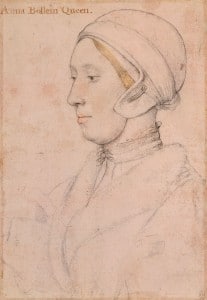 Bendor Grosvenor, historian and art dealer, has just published an interesting article on his Art History News blog entitled Anne Boleyn regains her head in which he discusses research he and David Starkey carried out a few years ago on the Holbein drawing inscribed “Anna Bollein Queen”.
Bendor Grosvenor, historian and art dealer, has just published an interesting article on his Art History News blog entitled Anne Boleyn regains her head in which he discusses research he and David Starkey carried out a few years ago on the Holbein drawing inscribed “Anna Bollein Queen”.
He has actually reproduced the article he wrote in 2006 for an exhibition at Philip Mould called ‘Lost Faces – Identity & Discovery in Tudor Royal Portraiture’, which was guest curated by David Starkey. It’s not ‘new’ news, but it is a very interesting read when compared with the thoughts of Eric Ives and Roland Hui, which you can read in “Anne Boleyn Portraits – Which is the True Face of Anne Boleyn?”